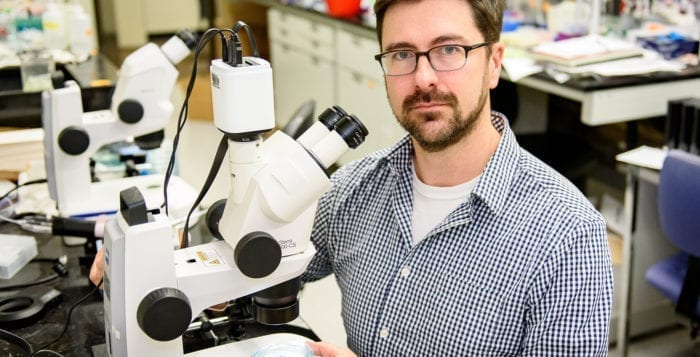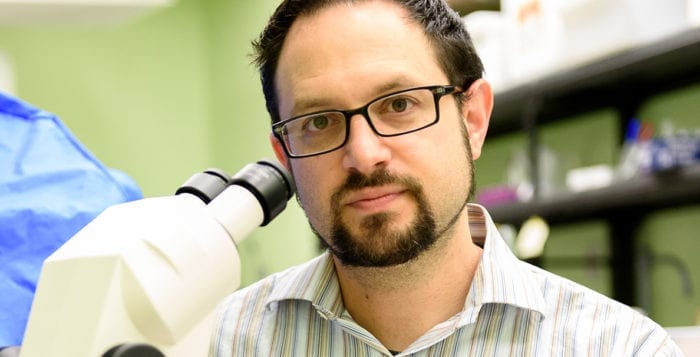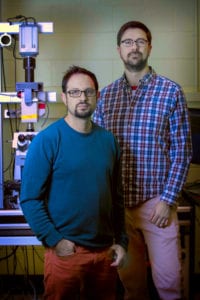By Daniel Dunaief
Last week, the Times Beacon Record Newspapers profiled the work of David Matus, an assistant professor in the Department of Biochemistry and Cell Biology. Matus and Benjamin Martin, who has the same title in the same department, are working together on a new cancer study.
While neither Matus nor Martin are cancer biologists, these researchers have experience in developmental biology with different organisms that could contribute to insights in cancer. Specifically, they are exploring the processes that lead to cell division or invasion. Matus is working with the transparent roundworm, while Martin is focusing on the zebrafish.
The duo recently won the 2017 Damon Runyon–Rachleff Innovation Award, which includes a grant of $300,000. Martin got involved in the research “based on learning more about [Matus’] work and the general hypothesis” about division and invasion, Martin said. The overall perspective is that the cell doesn’t “invade through tissues and divide at the same time.”
Martin has done innovative work with a neuromesodermal progenitor in the zebrafish. These cells are highly plastic and can give rise to numerous other cell types. Martin is focused on trying to understand the basic biology of these cells.
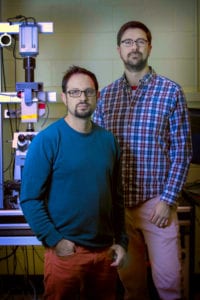
Martin is known for the “very original discovery that a signaling protein called Wnt can regulate the decision between these progenitor cells becoming muscle or neurons,” explained David Kimelman, a professor of Biochemistry at the University of Washington who oversaw Martin’s research when he was a postdoctoral student.
“What is very nice is that [Martin’s] discovery in zebrafish has since been replicated in other organisms such as the mouse and even in human stem cells, showing that this is a fundamental property of vertebrates,” Kimelman explained in an email.
Similar to Matus’ work with the worm, Martin has been working with cells that go through invasive behavior and don’t engage in cell proliferative activities. “We already knew that notochord progenitors are not proliferating when they undergo convergence and extension” from other published works, explained Martin in an email. “Since notochord progenitors exist in the tailbud and we were already studying them, it was a natural jumping off point to address the same question.”
Martin is testing a transcription factor, called brachyury, which drives metasasis-like behavior in human cancer cells. He has studied this transcription factor in the context of early zebrafish development and will see if it helps drive metastasis through inhibition of the cell cycle. At this point, Martin said, there is some “evidence that it does arrest the cell cycle” using human cells in another lab.
So far, the work he has done with brachyury and the cell cycle/invasion in zebrafish is preliminary. Their hypothesis is that halting the cell cycle is a prerequisite for invasive behavior. Like the roundworm, the embryonic zebrafish is transparent, which makes it easier to observe cellular changes.
One of the goals of the project is “to observe the cell cycle of human cancer as it invades through tissues in the fish embryo,” Martin said. In the long term, he hopes to see whether the overexpression of a transcription factor Matus has found in the worm is sufficient to drive metastasis in the zebrafish.
Martin described winning the Damon Runyon–Rachleff Award as “exciting,” and suggested that it “pushes back a little bit of the worry phase” of finding funding for compelling scientific projects. Kimelman said Martin is an “exceptional scientist” and one of the “best I have had the privilege to train.”
Kimelman believes the work Martin and Matus are doing has the potential to provide “important insight into the basic changes that occur during cancer as cells become metastatic,” he explained in an email. “While it doesn’t immediately lead to a therapeutic, understanding the basic biology of cancer is the first step to defining new ways of affecting it.”
Kimelman particularly appreciated the way Matus and Martin combined two different model systems, which offers the potential to provide insight into the basic changes that occur during cancer as cells become metastatic.
Martin learned about science and research during his formative years. His father Presley Martin was a graduate student at Johns Hopkins in Baltimore when the younger Martin was born. Presley Martin recently retired from Hamline University in St. Paul, Minnesota, where he studied the genetics of the fruit fly Drosophila. “At a young age, I was exposed to a lot of the lab and experiments and it was certainly appealing to me,” said Martin.
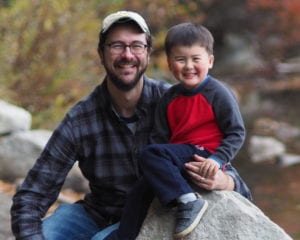
Martin is married to Jin Bae, whom he met at the University of California at Berkeley, where he was studying the molecular control of how muscle precursor cells move to distant parts of the embryo in frogs and fish. Bae is a registered nurse at Stony Brook Hospital. The couple’s son Calvin, who enjoys visiting the lab, will be four in April.
Matus and Martin are collaborating with Scott Powers, a professor in the Department of Pathology at Stony Brook, and Eric Brouzes, an assistant professor in the Department of Biomedical Engineering at Stony Brook.
Powers said the work Martin and Matus are doing is a “basic discovery but an important one,” he explained in an email. “Conceivably, further research could lead to translation but as of right now, any thoughts along those lines are speculative.”
Martin appreciates the opportunity to work on these cells that are so important in development and that might lead to insights about cancer. “It seems like in the past few years” these discoveries have “opened up a subfield of developmental biology,” he said. “It’s exciting to see.”

